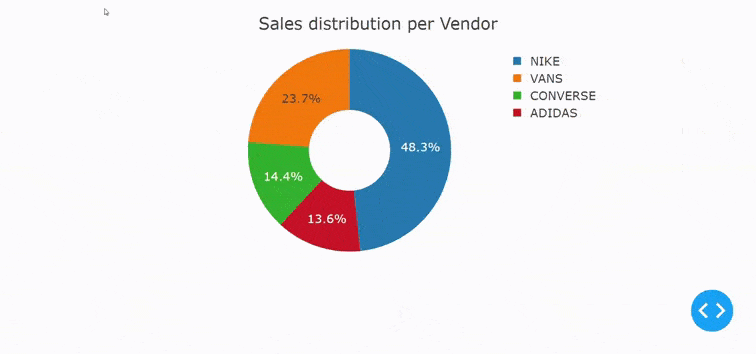如何在Dash Plotly中对各种图形执行向下钻取操作?
我正在尝试对Dash Plotly中的各种图形执行向下钻取操作,但找不到任何提供的教程或文档。
我尝试了YouTube上的一些教程,还尝试了google上的一些文档,但是没有一种可以真正满足我要求的正确的代码方式。
要求是,当用户单击条形图中的条形时,应在同一位置显示另一个条形图,以表示内部层数据。预先感谢!
2 个答案:
答案 0 :(得分:0)
我在这里看到了类似的实现,可能对您有帮助 https://community.plot.ly/t/drill-down-function-for-graphs-embedded-in-dash-app/12290
答案 1 :(得分:-1)
在 callback_context 的帮助下查看 Dash 中的 Drill Down 示例。

在这个例子中,我只展示了一个单一级别的向下钻取,以保持简单,但只需稍作修改,就可以实现多级向下钻取。 有一个返回按钮可以返回到原始图形。后退按钮仅显示在向下钻取的第二层,隐藏在原始底层。
代码:
import dash
import dash_core_components as dcc
import dash_bootstrap_components as dbc
from dash.dependencies import Input, Output
import plotly.express as px
import pandas as pd
app = dash.Dash(__name__, external_stylesheets=[dbc.themes.BOOTSTRAP])
# creating a dummy sales dataframe
product_sales = {'vendors':['VANS','VANS','VANS','VANS','NIKE','NIKE','NIKE','ADIDAS','ADIDAS','CONVERSE','CONVERSE','CONVERSE'],
'products': ['Tshirts','Sneakers','Caps','Clothing','Sports Outfit','Sneakers','Caps','Accessories','Bags','Sneakers','Accessories','Tshirts'],
'units sold': [2,15,3,8,37,13,7,4,12,7,8,2]
}
product_sales_df = pd.DataFrame(product_sales)
# all vendors sales pie chart
def sales_pie():
df = product_sales_df.groupby('vendors').sum().reset_index()
fig = px.pie(df, names='vendors',
values='units sold', hole=0.4)
fig.update_layout(template='presentation', title='Sales distribution per Vendor')
return fig
# creating app layout
app.layout = dbc.Container([
dbc.Card([
dbc.Button('?', id='back-button', outline=True, size="sm",
className='mt-2 ml-2 col-1', style={'display': 'none'}),
dbc.Row(
dcc.Graph(
id='graph',
figure=sales_pie()
), justify='center'
)
], className='mt-3')
])
#Callback
@app.callback(
Output('graph', 'figure'),
Output('back-button', 'style'), #to hide/unhide the back button
Input('graph', 'clickData'), #for getting the vendor name from graph
Input('back-button', 'n_clicks')
)
def drilldown(click_data,n_clicks):
# using callback context to check which input was fired
ctx = dash.callback_context
trigger_id = ctx.triggered[0]["prop_id"].split(".")[0]
if trigger_id == 'graph':
# get vendor name from clickData
if click_data is not None:
vendor = click_data['points'][0]['label']
if vendor in product_sales_df.vendors.unique():
# creating df for clicked vendor
vendor_sales_df = product_sales_df[product_sales_df['vendors'] == vendor]
# generating product sales bar graph
fig = px.bar(vendor_sales_df, x='products',
y='units sold', color='products')
fig.update_layout(title='<b>{} product sales<b>'.format(vendor),
showlegend=False, template='presentation')
return fig, {'display':'block'} #returning the fig and unhiding the back button
else:
return sales_pie(), {'display': 'none'} #hiding the back button
else:
return sales_pie(), {'display':'none'}
if __name__ == '__main__':
app.run_server(debug=True)
另请查看此 thread 以了解更多信息。
相关问题
最新问题
- 我写了这段代码,但我无法理解我的错误
- 我无法从一个代码实例的列表中删除 None 值,但我可以在另一个实例中。为什么它适用于一个细分市场而不适用于另一个细分市场?
- 是否有可能使 loadstring 不可能等于打印?卢阿
- java中的random.expovariate()
- Appscript 通过会议在 Google 日历中发送电子邮件和创建活动
- 为什么我的 Onclick 箭头功能在 React 中不起作用?
- 在此代码中是否有使用“this”的替代方法?
- 在 SQL Server 和 PostgreSQL 上查询,我如何从第一个表获得第二个表的可视化
- 每千个数字得到
- 更新了城市边界 KML 文件的来源?